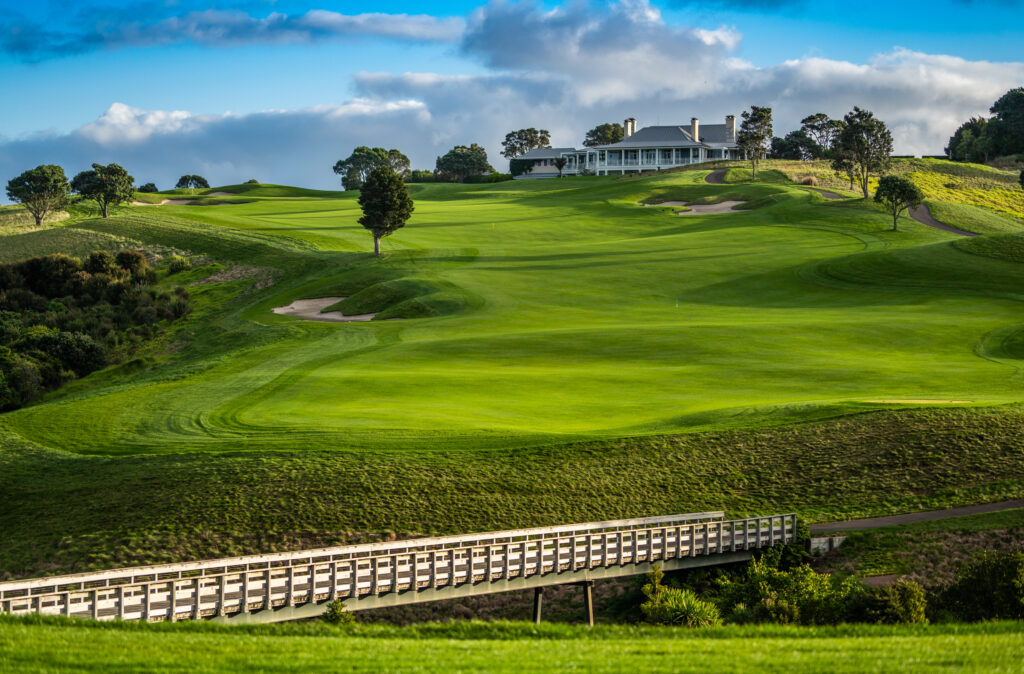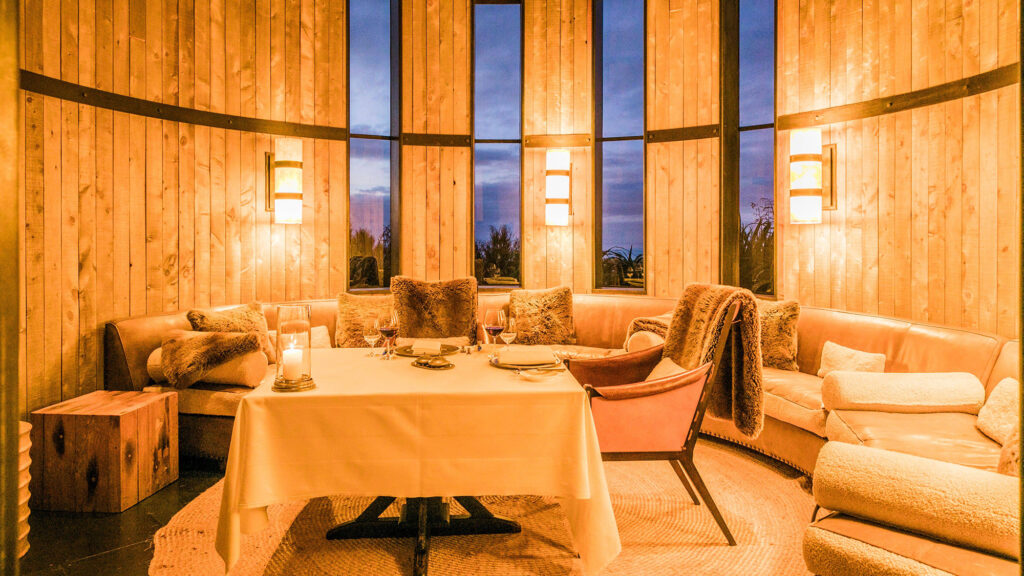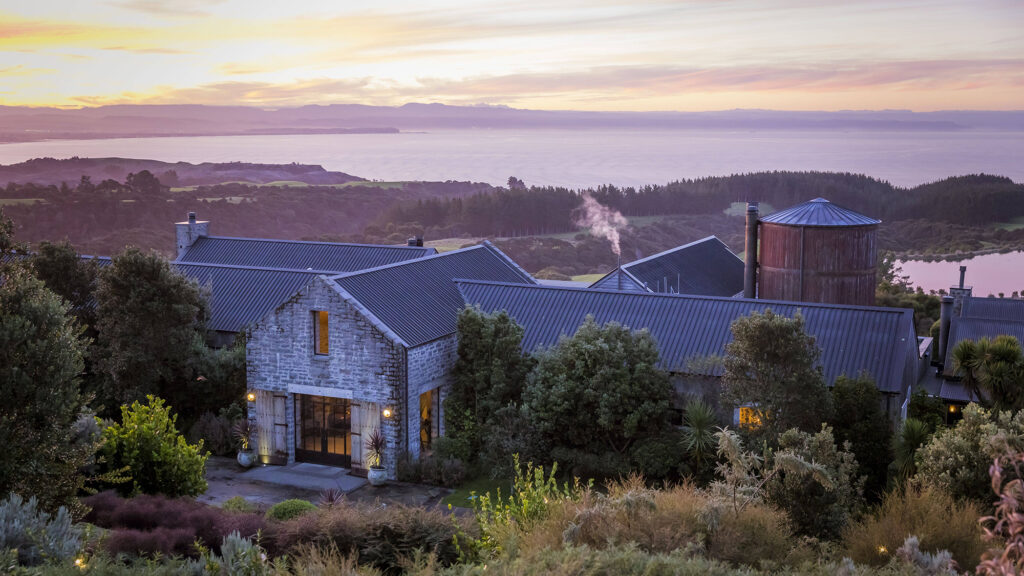The late Julian Robertson – visionary American billionaire and philanthropist who founded New Zealand’s famed Kauri Cliffs – had a saying he used tongue-in-cheek when explaining why there was an unsealed gravel road leading up to his wildly opulent resort on the North Island: “You need to go through rough times to get to paradise.”
Robertson was joking about the road, but there was wisdom in his words. The journey to a happy place often includes dark times, and the origins of Kauri Cliffs are no different.
The North Carolinian wanted to leave the United States in the early 1990s despite creating one of the biggest hedge funds in the world, New York’s Tiger Management. Crime was soaring across America, Los Angeles had rioted after the violent arrest of Rodney King in 1992, and the World Trade Center experienced its first terrorist attack in 1993.
Having already spent some time in New Zealand in the 1970s, Robertson and his wife, Josie, purchased a 2,500-hectare farm on the ocean at Matauri Bay, almost 300 kilometres north of Auckland. Robertson, who Forbes estimated to have a $4 billion fortune, commissioned Florida’s David Harman to build a golf course at the subtropical Northland site for visiting American friends to play. But Josie convinced her husband to convert it into an operational, high-end golf resort.

Kauri Cliffs opened in 2001 and quickly developed international acclaim. That success laid the foundation for a sister property on the North Island – Cape Kidnappers. It’s a stunning, rustic estate perched high above the wine country of Hawke’s Bay with a course designed by Tom Doak. Then came Matakauri Lodge, an unfathomably opulent resort, sans golf course, in Queenstown that once welcomed Prince Harry. Pouring fuel on the hype was a handful of iconic aerial photos showing Cape Kidnappers’ collection of holes that run along a series of cliffs high above the sea. To this day, they still float on social media but have been superseded by drone photography.
The meteoric rise of the lodges was also fuelled by their public accessibility. Yes, the price may add exclusivity, but anyone who can afford the premium rates can stay and play. “Julian Robertson built Kauri Cliffs and Cape Kidnappers because he loved New Zealand and wanted to attract more people there,” Doak tells Australian Golf Digest. “The fact the course was open to the public was key to it getting so much attention. If it were private, the golf magazines wouldn’t run all those pictures of the course because the readers couldn’t go there.”
What did finally render the two courses inaccessible, at least to foreigners, was the global COVID-19 pandemic. New Zealand’s strict international border closures forced Robertson Lodges to think outside the square given their properties are usually 70 percent occupied by American guests. The remaining guests are mainly from Australia, with Europe and Asia a small percentage. Australians love the discounted lodge rates in the shoulder seasons of autumn and spring, as well as winter. Americans populate the lodges during summer (their winter).
The pandemic resembled the tough times Robertson often alluded to; all three properties were closed for at least six months in 2020. In 2021, only domestic travellers could visit the lodges. Even then, Auckland residents couldn’t leave the city limits. But Robertson Lodges saw an opportunity to undergo significant maintenance work at Kauri Cliffs and Cape Kidnappers. Kauri Cliffs now has brand new greens and restored fairways, while the near-20-year-old greens at Cape Kidnappers were restored to their original perimeters. Greens staff then resurfaced the bentgrass greens and fairways.
“We’ve utilised COVID to re-imagine and upgrade the infrastructure,” says Callum Farnell, director of hospitality at Robertson Lodges. “Both courses had a significant amount of money invested in them. The feedback has been phenomenal.”

A return to paradise
It’s January 2023, and the rough times seem to be in the rear-view mirror. Kauri Cliffs’ timber exterior has the look and feel of a mansion in the Hamptons. It’s bustling with well-heeled guests, mostly Americans looking to escape the Northern Hemisphere winter.
From the deck of this palatial lodge, the view down the golf course, through the scattered patches of rainforest and across Matauri Bay, are a picturesque reminder that this writer has also navigated through a tough period to get back to paradise.
Paradise, for me, is doing what I love and what I love doing is writing about golf. Mostly that’s golf news, but sometimes there’s travel writing. From 2016 to 2020, I was the golf correspondent in the US covering the PGA Tour and LPGA Tour for the Australian Associated Press (AAP) newswire as well as Australian Golf Digest. It was the dream job. But in February 2020, just before COVID
kicked off, AAP’s major shareholders withdrew. The newswire very nearly closed and had to slash its newsroom in half. That meant no more golf writers on the PGA Tour.
I had to move back to Australia, where I took a job with News Corp covering general news: crime, COVID and everything in between. When the world picked back up in late 2021, Australian Golf Digest offered me a return to the magazine and sent me back to the US. This New Zealand work trip was a bonus while back in Australia for Christmas.
Kauri Cliffs had not changed since my first visit in 2015. The front nine is still as majestic as I remembered. Golfers begin the round high up on the property and zigzag down the valley towards the ocean. There are no weak holes before the turn. Stopping to take photos is irresistible; particularly at the fourth hole, a par 5 named “Cambo” after 2005 US Open winner and proud Maori man, Michael Campbell, as well as the beautiful and daunting par 3s at the fifth and seventh. The former is a downhill wedge shot but the latter requires a 160-metre carry across a cliff to a green perched right on the edge of the property, with the enchanting Cavalii Islands directly behind. While holes 10 to 13 are relatively mediocre, they set up a thrilling finish. The par-3 14th begins an exhilarating four-hole stretch full of twists, turns and hero tee shots high above the sea. All up, 15 holes at Kauri Cliffs face the South Pacific Ocean; six traversing tall cliffs that plunge to the water below.

What had changed – or evolved – since 2015 was my understanding of Kauri Cliffs as an American-style golf resort now that I live in the US. It’s built for relaxation and comfort and that is reflected in the resort-style course: all the trouble is visible and the bunkers are manageable. Providing one plays from the correct tees, it’s a relatively forgiving layout. The views, topography and routing are awe-inspiring, but architecturally the course can’t compete with Cape Kidnappers. In a way, Kauri Cliffs is like Pebble Beach Golf Links or the Plantation and Bay courses at Kapalua Resort in Hawaii (though Kauri Cliffs has far superior accommodation). Cape Kidnappers is more comparable to Pinehurst or Bandon Dunes. Both Kauri and Cape regularly feature in the top 100 courses in the world, with Cape Kidnappers reaching as high as 16th. But playing both on your trip provides a wonderful contrast; their sum is greater than the individual parts.
The overall experience is more quintessentially and wonderfully American at Kauri Cliffs than at Cape Kidnappers. That’s evident in the traditional Hamptons feel inside the lodge, restaurant and villas. But the resort has a pure New Zealand twist; when they’re not playing golf, guests are hiking up to a forest, to marvel at a 900-year-old Kauri tree and then down farmland to a waterfall. This is no gentle stream; it’s a raging miniature version of Niagara Falls. Families are also fishing on the resort’s handful of private beaches, including the very tranquil Pink Beach, or riding horses along the mesmerising ridges.
Although Kauri Cliffs is the original property, the star of the portfolio is Cape Kidnappers. There’s a heightened sophistication found in the golf course, the atmosphere, the service and the rare local wines.
The centrepiece of Cape Kidnappers is the golf course, which ranks high among Doak’s finest architectural achievements. That is saying something for a sought-after designer from Michigan whose stable includes Pacific Dunes at Bandon in Oregon; Tara Iti, a course located two hours north of Auckland ranked No.2 in the world; and the wildly popular Barnbougle Dunes in Tasmania. To build and route a world-class layout on the difficult site Doak was given at Cape Kidnappers is perhaps forgotten among the dramatic aerial imagery of the property.

“Cape Kidnappers was an interesting routing to do,” Doak says. “The topography insisted on routing holes north and south on the fingers of the land. Going out along those fingers was obviously super-dramatic; the golfer is playing towards the ocean and generally hugging a deep valley on one side of the hole. Those valleys were too deep to play east-west across them.”
Cape Kidnappers may not have quite as many holes with ocean views as Kauri Cliffs, but it does more with its panoramas and finds intriguing solutions to its inland holes. To achieve that, Doak employed design principles similar to Barnbougle Dunes or layouts on the Melbourne Sandbelt, like Yarra Yarra, which he recently restored: there’s always more room off the tee than the eye can see. The fairways are generous but have sides from which hitting the green can be either straightforward or nearly impossible; and the ground game is encouraged on most approach shots. There are also elements of links golf in the many blind shots you’ll hit.
“From the cliffs at Cape Kidnappers, you look down at Hawke’s Bay 130 metres below, and the waves coming to shore look like the ripples after you’ve thrown a pebble into a pond,” Doak once wrote on his website about the land. “We could not compete with such drama, so instead we tried to use it as best we could.”
Several stetches at Cape Kidnappers showcase Doak’s thoughtful use of the land. After three dramatic ocean holes – the par-5 fourth to the par-3 sixth – the course turns south back towards the clubhouse. There, Doak took the rolling valleys and created three exciting holes starting at the short par-4 seventh. The elevation changes, perched greens and rugged bunkering give the trio the appearance of a San Francisco-area course like the California Club.
“That was the difficult part; finding a variety of ways to use the topography to create interest on the holes that played back to the south without much view,” says Doak.
Holes 10, 11, 12, 13 and 15 are the stars of the back nine. The par-4 12th has a green positioned cleverly between a flat fairway and the horizon to give the golfer the feeling of putting on the edge of the earth. “It’s the natural tilt of the land towards Hawke’s Bay that gives the greens their infinity backdrop, and also makes it hard to get your approach to stay on them,” Doak wrote.
The par-3 13th is a brilliant uphill one-shotter with the ocean left and a concealed, rugged bunker more on the cliff-face than the green. “There are only 40 bunkers on the course, and many of them are unseen, hanging down into a valley well below the fairway or green,” Doak writes.
The par-5 15th [see page 94], called “Plank”, is Cape Kidnappers’ most famous hole. At nearly 600 metres, this three-shotter runs almost as straight as an airport runway along a cape with a 50-metre drop to the ocean on either side. But the driveable par-4 14th before that – which is wide open from the tee but incredibly demanding on approaches hit from inside 70 metres – is just as much fun. The course ends deservingly on a classy trio of inland holes.
Cape Kidnappers had long enjoyed the mantle of New Zealand’s best course before it was usurped in 2016 by Doak’s other New Zealand masterpiece, Tara Iti. But the man himself says Cape Kidnappers is probably the most unique course he’s designed.
“While people may like the vibe of links golf at Tara Iti better, there are lots of links courses in other parts of the world that [Tara Iti] has to compete with for attention,” Doak says. “There is really no other course with the setting of Cape Kidnappers in the USA, or in the UK, or Australia. You’ve got to go to New Zealand for that.”
One also must go to New Zealand for the food at Cape Kidnappers. Without exaggeration, it alone is worth the trip. Head chef James Honore and his team harvest an abundance of crops from the resort’s own vegetable, fruit and herb gardens. Combined with incredible New Zealand meats and freshly caught seafood, the fine dining menus are as memorable as the golf course. Some of the highlights of these seasonal summer dishes included a Middle Eastern lentil salad with candied walnuts, a Thai curry of kingfish and a ribeye with red wine jus and beetroot puree.
The food at Cape Kidnappers is expertly paired with incredible local wines, some of which you may never have heard of, and would struggle to purchase in Australia. That’s because the celebrated Hawke’s Bay wine region is at the doorstep of Cape Kidnappers. It’s the second-largest wine producing region in New Zealand. Hawke’s Bay’s gravely soil and extended growing season allow for rich red blends, as well as merlot, spicy syrah and pinot noirs. For whites, there’s also delightful full-bodied chardonnays, oaky sauvignon blancs, crisp viogniers and aromatic pinot gris. Almost daily, Cape Kidnappers’ sommelier visits the cellar doors after hearing from the chefs about the menu and collects wines to complement the ever-changing dishes. During our stay, the highlights came from Hawke’s Bay winemakers like Topsy Turvey, Te Mata, Church Road, Smith & Sheth (which is at Havelock North) and the more heralded Craggy Range.

Where all this delectable food and wine is consumed within the Cape Kidnappers main lodge adds to the experience. The dining room has floor-to-ceiling glass doors that look over the garden and Hawke’s Bay towards Napier. There are also private dining rooms like The Snug – a cylindrical room within a red silo – creating the feeling guests are inside the barn of a billionaire’s ranch in Colorado or Montana. While the oak and stone transports guests to the American Rocky Mountains, there’s also an array of furniture pieces that add to Cape Kidnappers’ cosmopolitan décor. There are coffee bean barrels from Indonesia, the “divorce chandelier” bought from Bruce Willis and Demi Moore’s property auction when the actor couple split, and Ralph Lauren tobacco leather sling chairs.
And then there’s the accommodation. Both Cape Kidnappers and Kauri Cliffs could make a claim to have the best accommodation in world golf. Both have been widely celebrated in annual awards by non-golf travel media, like Conde Nast Traveler and Travel + Leisure, among others. The inconceivably plush villas at both properties range from suites to the Owners Cottages (Kauri Cliffs even has four-bedroom apartments called The Residences). The rooms are as breathtaking as the courses they gaze over. Kauri Cliffs’ suites have a coastal retreat atmosphere courtesy of blue and white tones, while those at Cape Kidnappers have a rustic look, an example being horse saddles hung from the walls.
This is all capped off by world-class service from an international array of hospitality virtuosos. It’s no wonder why billionaire Microsoft founder Bill Gates has previously hired the entire Kauri Cliffs resort, or why The Beatles icon Paul McCartney rented the Owners Cottage at Cape Kidnappers during a 2017 visit.
Hospitality director Farnell says it wasn’t just the two golf courses that put New Zealand on the map. He’d know, being a veteran hotelier who has previously worked in luxury lodges throughout New Zealand and even the Savoy Hotel in London. Farnell asserts that Robertson Lodges forced New Zealand’s entire luxury industry to elevate its food, accommodation and service.
“It wasn’t just golf in terms of how much the Robertson Lodges lifted the bar for re-imagining what a luxury lodge means in New Zealand,” Farnell says from inside the library at Cape Kidnappers. “These properties really set a benchmark. I’ve been in the industry for 30 years, and I’ve seen [New Zealand] elevate itself beyond being just a great country that had some good food and good service. But the infrastructure was never really there. These properties made New Zealand’s luxury sector lift its game tenfold. New Zealand really came of age when the Robertsons first launched Kauri Cliffs and many other properties have aspired to follow in its footsteps.”
As Farnell speaks, I notice a curious artwork on one of the library shelves. Farnell turns around and reveals it’s an original Picasso. The late Robertson passionately collected artworks from iconic artists like Pablo Picasso, Salvador Dali and Henri Matisse. Before Robertson died last August, he donated 15 masterpieces to the Auckland Art Gallery worth an estimated $300 million. It was part of Robertson’s philanthropic efforts to give back to a country that gave him so much. The artwork is nice, but it could be argued Robertson’s greatest gift to New Zealand was putting its golf industry on the map.
Did you know?
Autumn is the best-value period for Australians to visit Kauri Cliffs and Cape Kidnappers, with Robertson Lodges offering Australian guests unlimited green fees per person (golf carts additional) included in their lodge rate. This offer is valid from April 1 to May 31, 2023.
Rates: Suites $1,035+GST per person, per night. Deluxe suites $1,160+GST per person, per night.
Standard inclusions apply, including breakfast, lunch and dinner, as well as pre-dinner cocktail hour and the unlimited green fees per person offer. Visit robertsonlodges.com/ for more.




